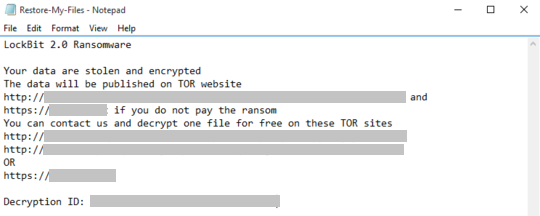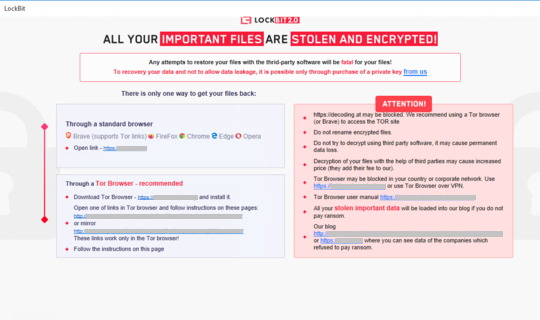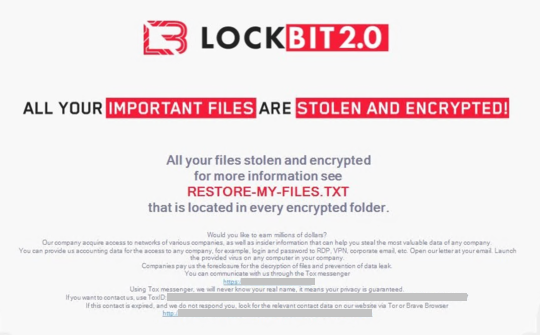Ransom.Win32.LOCKBIT.ENK
Win32:LockBit-A [Ransom] (AVAST)
Windows


Threat Type: Ransomware
Destructiveness: No
Encrypted: Yes
In the wild: Yes
OVERVIEW
Downloaded from the Internet, Dropped by other malware
This Ransomware arrives on a system as a file dropped by other malware or as a file downloaded unknowingly by users when visiting malicious sites.
It executes then deletes itself afterward.
It drops files as ransom note. It avoids encrypting files with the following file extensions.
TECHNICAL DETAILS
982,528 bytes
EXE
Yes
Encrypts files, Displays graphics/image, Displays message/message boxes, Drops files, Terminates processes
Arrival Details
This Ransomware arrives on a system as a file dropped by other malware or as a file downloaded unknowingly by users when visiting malicious sites.
Installation
This Ransomware drops the following copies of itself into the affected system:
- {Desktop or temp folder of connected devices}\{Random characters}.exe
It drops the following files:
- {Drive}\{Random characters}.lock
- %System%\{Random characters}.ico (Icon image for encrypted files)
- %User Temp%\{Random characters}.tmp.bmp (Background image)
(Note: %System% is the Windows system folder, where it usually is C:\Windows\System32 on all Windows operating system versions.. %User Temp% is the current user's Temp folder, which is usually C:\Documents and Settings\{user name}\Local Settings\Temp on Windows 2000(32-bit), XP, and Server 2003(32-bit), or C:\Users\{user name}\AppData\Local\Temp on Windows Vista, 7, 8, 8.1, 2008(64-bit), 2012(64-bit) and 10(64-bit).)
It adds the following processes:
- "%System%\cmd.exe" /c vssadmin delete shadows /all /quiet & wmic shadowcopy delete & bcdedit /set {default} bootstatuspolicy ignoreallfailures & bcdedit /set {default} recoveryenabled no (Process to delete shadow files)
- "%System%\cmd.exe" /C ping 127.0.0.7 -n 3 > Nul & fsutil file setZeroData offset=0 length=524288 "{Malware file path and name}" & Del /f /q "{Malware file path and name}" (Process to delete itself)
- "%System%\mshta.exe" "%Desktop%\LockBit_Ransomware.hta" {GUID} (Process to display ransom note)
- powershell.exe -Command "Get-ADComputer -filter * -Searchbase '%s' | foreach{ Invoke-GPUpdate -computer $_.name -force -RandomDelayInMinutes 0}" (Process to query connected machines and invoke group policy update)
(Note: %System% is the Windows system folder, where it usually is C:\Windows\System32 on all Windows operating system versions.. %Desktop% is the current user's desktop, which is usually C:\Documents and Settings\{User Name}\Desktop on Windows 2000(32-bit), XP, and Server 2003(32-bit), or C:\Users\{user name}\Desktop on Windows Vista, 7, 8, 8.1, 2008(64-bit), 2012(64-bit) and 10(64-bit).)
It executes then deletes itself afterward.
Autostart Technique
This Ransomware adds the following registry entries to enable its automatic execution at every system startup:
HKEY_CURRENT_USER\Software\Microsoft\
Windows\CurrentVersion\Run
{GUID} = "{Malware file path and name}" (Initial value before encryption finishes)
HKEY_CURRENT_USER\Software\Microsoft\
Windows\CurrentVersion\Run
{GUID} = "%Desktop%\LockBit_Ransomware.hta"
Other System Modifications
This Ransomware adds the following registry entries:
HKEY_CURRENT_USER\Software\{Random characters}
Private = {Generated session key}
HKEY_CURRENT_USER\Software\{Random characters}
Public = {Generated session key}
HKEY_LOCAL_MACHINE\SOFTWARE\Classes\
.lockbit
(Default) = LockBit
HKEY_CLASSES_ROOT\.lockbit
(Default) = LockBit
HKEY_LOCAL_MACHINE\SOFTWARE\Classes\
.lockbit\DefaultIcon
(Default) = %System%\{Random characters}.ico
HKEY_CLASSES_ROOT\Lockbit\shell\
Open\Command
(Default) = "%System%\mshta.exe" "%Desktop%\LockBit_Ransomware.hta"
HKEY_CURRENT_USER\Control Panel\Desktop
Wallpaper = %User Temp%\{Random characters}.tmp.bmp
HKEY_CURRENT_USER\Control Panel\Desktop
WallpaperStyle = 2
HKEY_CURRENT_USER\Control Panel\Desktop
TileWallpaper = 0
It sets the system's desktop wallpaper to the following image:
Other Details
This Ransomware adds the following registry keys:
HKEY_CURRENT_USER\Software
{Random characters} =
HKEY_LOCAL_MACHINE\SOFTWARE\Classes
.lockbit =
HKEY_CLASSES_ROOT
.lockbit =
HKEY_CLASSES_ROOT
Lockbit =
It does the following:
- It enumerates printers in the network to print the ransom note.
- It uses LDAP queries and connected network shares/volumes to collect connected machines in the network.
- It performs a group policy update to connected machines for propagation and execution.
- It performs SMB queries by connecting to {Random IP in the network}:445 for propagation and execution.
- It creates a scheduled task with random file name to execute the copied ransomware and terminate processes.
- It bypasses UAC to escalate its privileges on infected machines.
- It modifies the following files inside the SYSVOL folder for modification of group policies:
- Registry.pol
- comment.cmtx
- NetworkShares.xml
- Services.xml
- ScheduledTasks.xml
- It pushes the following group policy updates to disable malware protection on queried machines:
- [Software\Policies\Microsoft\Windows Defender;DisableAntiSpyware]
- [Software\Policies\Microsoft\Windows Defender\Real-Time Protection;DisableRealtimeMonitoring]
- [Software\Policies\Microsoft\Windows Defender\Spynet;SubmitSamplesConsent]
- [Software\Policies\Microsoft\Windows Defender\Threats;Threats_ThreatSeverityDefaultAction]
- [Software\Policies\Microsoft\Windows Defender\Threats\ThreatSeverityDefaultAction]
- [Software\Policies\Microsoft\Windows Defender\UX Configuration;Notification_Suppress]
- It terminates the following processes and services with the following strings in their paths:
- 360doctor
- 360se
- acwebbrowser
- adexplorer
- adexplorer64
- adexplorer64a
- adobe cef
- adobe desktop service
- adobecollabsync
- adobeipcbroker
- agntsvc
- autodeskdesktopapp
- autoruns
- autoruns64
- autoruns64a
- autorunsc
- autorunsc64
- autorunsc64a
- avz
- axlbridge
- bedbh
- benetns
- bengien
- beserver
- brccuxsys
- brctrlcntr
- cagservice
- coresync
- creative cloud
- culture
- dbeng50
- dbsnmp
- defwatch
- dellsystemdetect
- dumpcap
- encsvc
- enterpriseclient
- excel
- fbguard
- fbserver
- fdhost
- fdlauncher
- gdscan
- glasswire
- gwctlsrv
- helper
- httpd
- infopath
- inputpersonalization
- isqlplussvc
- j0gnjko1
- java
- koaly-exp-engine-service
- msaccess
- msdtsrvr
- mspub
- mydesktopqos
- mydesktopservice
- mysqld
- node
- notepad
- notepad++
- ocautoupds
- ocomm
- ocssd
- onenote
- onenotem
- oracle
- outlook
- powerpnt
- processhacker
- procexp
- procexp64
- procexp64a
- procmon
- procmon64
- procmon64a
- pvlsvr
- qbdbmgr
- qbdbmgrn
- qbidpservice
- qbupdate
- qbw32
- raccine
- raccine_x86
- raccineelevatedcfg
- raccinesettings
- ragui
- raw_agent_svc
- rdrcef
- rtvscan
- sam
- simply
- simplyconnectionmanager
- sqbcoreservice
- sqlbrowser
- sqlmangr
- sqlservr
- ssms
- steam
- supervise
- sync-taskbar
- sync-worker
- synctime
- sysmon
- sysmon64
- systemexplorer
- systemexplorerservice
- systemexplorerservice64
- systemtrayicon
- tbirdconfig
- tcpview
- tcpview64
- tcpview64a
- tdsskiller
- teamviewer
- teamviewer_service
- thebat
- thunderbird
- titanv
- tomcat6
- totalcmd
- totalcmd64
- tv_w32
- tv_x64
- veeamdeploymentsvc
- visio
- vsnapvss
- vxmon
- wdswfsafe
- winword
- wireshark
- wordpad
- wsa_service
- wxserver
- wxserverview
- xfssvccon
- zhudongfangyu
- It encrypts files found in the following drive types:
- Fixed drive
- Removable drive
- Network drive
- RAM disks
Ransomware Routine
This Ransomware avoids encrypting files with the following strings in their file name:
- autorun.inf
- bootsect.bak
- iconcache.db
- ntldr
- ntuser.dat.log
- Restore-My-Files.txt
- thumbs.db
It avoids encrypting files with the following strings in their file path:
- $recycle.bin
- $windows.~bt
- $windows.~ws
- all users
- appdata
- application data
- boot
- common files
- intel
- internet explorer
- microsoft
- microsoft shared
- microsoft.net
- mozilla
- msbuild
- msocache
- opera
- perflogs
- system volume information
- tor browser
- windows
- windows journal
- windows nt
- windows.old
It appends the following extension to the file name of the encrypted files:
- .lockbit
It drops the following file(s) as ransom note:
- {Encrypted directory}\Restore-My-Files.txt

- %Desktop%\LockBit_Ransomware.hta

It avoids encrypting files with the following file extensions:
- .386
- .adv
- .ani
- .apk
- .app
- .bat
- .bin
- .cmd
- .com
- .cpl
- .cur
- .diagcab
- .diagcgf
- .diagpkg
- .dll
- .dmg
- .dmp
- .drv
- .drv
- .exe
- .fnt
- .fon
- .gadget
- .hlp
- .hlp
- .hta
- .icns
- .ico
- .ics
- .idx
- .ini
- .ipa
- .iso
- .key
- .lnk
- .lock
- .lockbit
- .mod
- .mp3
- .mp4
- .mpa
- .msc
- .msi
- .msstyles
- .msp
- .msu
- .msu
- .nls
- .ocx
- .otf
- .part
- .pif
- .prf
- .rdp
- .reg
- .rom
- .rtp
- .sfcache
- .shs
- .spl
- .sys
- .theme
- .tmp
- .ttf
- .wad
- .wav
- .wma
- .woff
- .wpx
- .xex
SOLUTION
9.800
16.904.06
14 Aug 2021
16.905.00
15 Aug 2021
Step 1
Trend Micro Predictive Machine Learning detects and blocks malware at the first sign of its existence, before it executes on your system. When enabled, your Trend Micro product detects this malware under the following machine learning name:
- TROJ.Win32.TRX.XXPE50FFF047
Step 2
Before doing any scans, Windows 7, Windows 8, Windows 8.1, and Windows 10 users must disable System Restore to allow full scanning of their computers.
Step 3
Note that not all files, folders, and registry keys and entries are installed on your computer during this malware's/spyware's/grayware's execution. This may be due to incomplete installation or other operating system conditions. If you do not find the same files/folders/registry information, please proceed to the next step.
Step 4
Restart in Safe Mode
Step 5
Delete this registry value
Important: Editing the Windows Registry incorrectly can lead to irreversible system malfunction. Please do this step only if you know how or you can ask assistance from your system administrator. Else, check this Microsoft article first before modifying your computer's registry.
- In HKEY_CURRENT_USER\Software\Microsoft\Windows\CurrentVersion\Run
- {GUID}="{Malware file path and name}" (Initial value before encryption finishes)
- {GUID}="{Malware file path and name}" (Initial value before encryption finishes)
- In HKEY_CURRENT_USER\Software\Microsoft\Windows\CurrentVersion\Run
- {GUID}="%Desktop%\LockBit_Ransomware.hta"
- {GUID}="%Desktop%\LockBit_Ransomware.hta"
Step 6
Delete this registry key
Important: Editing the Windows Registry incorrectly can lead to irreversible system malfunction. Please do this step only if you know how or you can ask assistance from your system administrator. Else, check this Microsoft article first before modifying your computer's registry.
- In HKEY_CURRENT_USER\Software
- {Random characters}
- {Random characters}
- In HKEY_LOCAL_MACHINE\SOFTWARE\Classes
- .lockbit
- .lockbit
- In HKEY_CLASSES_ROOT
- .lockbit
- .lockbit
- In HKEY_CLASSES_ROOT
- Lockbit
- Lockbit
Step 7
Search and delete this file
- {Desktop or temp folder of connected devices}\{Random characters}.exe
- {Encrypted directory}\Restore-My-Files.txt
- %Desktop%\LockBit_Ransomware.hta
- {Drive}\{Random characters}.lock
- %System%\{Random characters}.ico
- %User Temp%\{Random characters}.tmp.bmp
Step 8
Restart in normal mode and scan your computer with your Trend Micro product for files detected as Ransom.Win32.LOCKBIT.ENK. If the detected files have already been cleaned, deleted, or quarantined by your Trend Micro product, no further step is required. You may opt to simply delete the quarantined files. Please check this Knowledge Base page for more information.
Step 9
Restore encrypted files from backup.
Step 10
Reset your Desktop properties
Step 11
Scan your computer with your Trend Micro product to delete files detected as Ransom.Win32.LOCKBIT.ENK. If the detected files have already been cleaned, deleted, or quarantined by your Trend Micro product, no further step is required. You may opt to simply delete the quarantined files. Please check the following Trend Micro Support pages for more information:
Did this description help? Tell us how we did.


